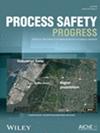评估与脂肪、油和油脂处理有关的风险:利用弓形分析从食品加工业污水中拦截油脂
IF 1
4区 工程技术
Q4 ENGINEERING, CHEMICAL
引用次数: 0
摘要
脂肪、油和油脂(FOG)是废水中的沉淀物,产生于食品和加工行业的任何加工过程。废水管理系统中的油脂沉积物会导致下水道系统堵塞。油脂拦截器(GI)是处理和防止下水道系统中油脂沉积物堵塞的控制措施之一。然而,很少有研究评估在处理油脂时使用隔油池的扩展危害。本研究旨在使用弓形技术评估在处理 FOG 时使用 GI 的风险。已确定的危害是 FOG 本身,而首要事件是 GI 故障。威胁程度较高的是消化道类型和设计的不适当变化、没有消化道清洗流程计划以及消化道流出管道堵塞。按照标准设计消化池和由持证油脂运输商清理消化池中的沉淀油脂是两个合适的预防屏障。清淤过程是保证消化道顺利运行的关键,也被认为是极佳的回收屏障。专家之间的可靠性(IRR)分析用于衡量他们对所提供数据的评分是否一致。专家们对资产的 IRR 风险评级值的总体一致值为 75%,而对人员的一致值为 50%。本文章由计算机程序翻译,如有差异,请以英文原文为准。
Evaluation of risk associated with treatment of fat, oil, and grease: Grease interceptor from food processing industry effluent using bowtie analysis
Fat, oil, and grease (FOG), a deposit in wastewater, develops from any processes in food and processing industries. FOG deposits in wastewater management systems can cause blockages in sewer systems. Grease Interceptor (GI) is one of the control measures to treat and prevent the blockage of FOG deposits in the sewer system. Nevertheless, few studies evaluate the extended hazard of GI application in FOG treatment. This study aims to assess the risk of GI in FOG treatment by using a bowtie technique. The hazard identified is FOG itself, whereas the top event was GI failure. The high contributions of the threats were an unsuitable variation of GI's type and design, no GI cleaning process schedule, and a clogged outflow pipe from GI. GI design according to standard and cleaning FOG deposits in GI by a licensed grease hauler were two suitable preventive barriers. The desludging process is essential to guarantee that the GI operates smoothly and is identified as an excellent recovery barrier. Inter-rater reliability (IRR) analysis to measure the consistency of their ratings on the data provided. The experts had a 75% overall agreement value of IRR risk rating value on assets, while 50% agreement value on people.
求助全文
通过发布文献求助,成功后即可免费获取论文全文。
去求助
来源期刊

Process Safety Progress
工程技术-工程:化工
CiteScore
2.20
自引率
10.00%
发文量
99
审稿时长
6-12 weeks
期刊介绍:
Process Safety Progress covers process safety for engineering professionals. It addresses such topics as incident investigations/case histories, hazardous chemicals management, hazardous leaks prevention, risk assessment, process hazards evaluation, industrial hygiene, fire and explosion analysis, preventive maintenance, vapor cloud dispersion, and regulatory compliance, training, education, and other areas in process safety and loss prevention, including emerging concerns like plant and/or process security. Papers from the annual Loss Prevention Symposium and other AIChE safety conferences are automatically considered for publication, but unsolicited papers, particularly those addressing process safety issues in emerging technologies and industries are encouraged and evaluated equally.
 求助内容:
求助内容: 应助结果提醒方式:
应助结果提醒方式:


